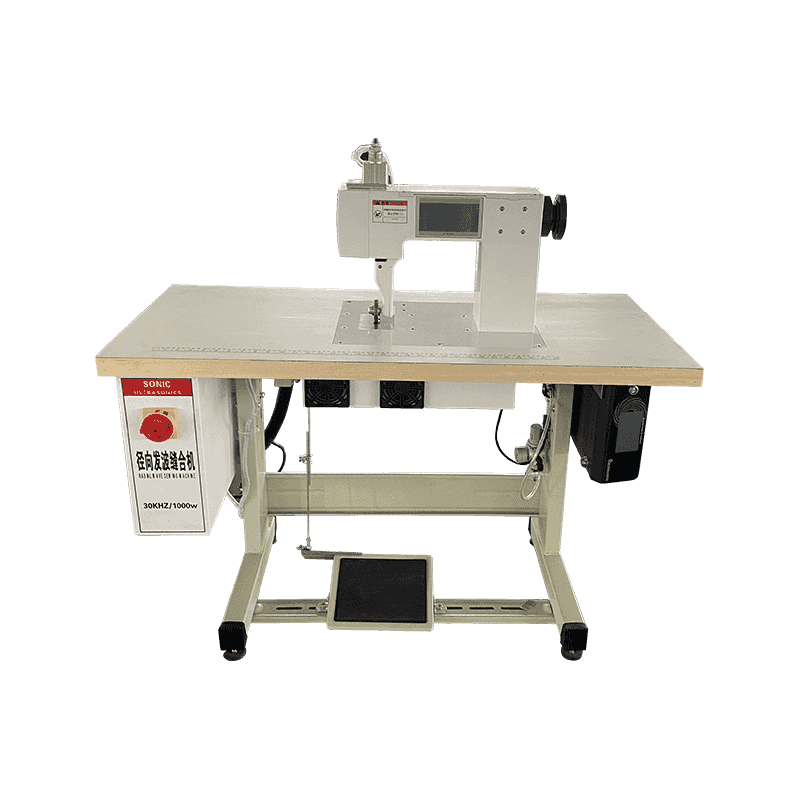Request A Quote

Ultrasonic sewing machines have become an innovative tool in textile production, providing several cost-saving benefits that contribute to reducing overall manufacturing costs. These machines use high-frequency sound waves (ultrasonic vibrations) to fuse or bond fabric layers together without the need for traditional stitching. Here’s how they help reduce costs in textile manufacturing:
Faster Production Speeds
High-Speed Welding: Ultrasonic sewing machines operate faster than traditional sewing machines because they bond materials together instantly using ultrasonic vibrations, which significantly reduces production time. This speed advantage allows manufacturers to produce more units in a given time frame, lowering labor costs and improving productivity.
No Need for Thread: Unlike traditional sewing, which requires the use of thread to stitch the fabric, ultrasonic welding does not require thread. This eliminates the cost of purchasing, storing, and managing thread inventory, while also removing the time and energy spent on threading and rethreading sewing machines.
Reduced Labor Costs
Minimal Operator Training: Ultrasonic sewing machines are generally easier to operate than conventional sewing machines, as they don’t require complex threading or stitching techniques. The operator's primary task is to position the fabric correctly, which reduces the training time and skill requirements for workers.
Automation Potential: Many ultrasonic sewing machines can be integrated into automated production lines, reducing the need for manual labor in repetitive tasks. This shift towards automation leads to fewer workers being needed for the same volume of output, thereby lowering labor costs.
Lower Material Waste
Precision and Minimal Damage: Traditional sewing techniques may result in material waste due to the nature of stitching, which can cause damage to the fabric or lead to issues like thread breakage. Ultrasonic welding creates strong bonds without the need for holes or punctures, which results in less fabric waste.
No Thread Waste: Since no thread is used in ultrasonic sewing, there’s no material loss or spools left over. Traditional sewing methods, in contrast, often result in thread wastage, especially during the setup and changing of sewing machines.
Reduced Need for Additional Finishing Processes
No Need for Additional Finishing Steps: Ultrasonic welding can create strong, clean, and durable seams without the need for additional finishing processes such as ironing, trimming, or sealing. This reduces the number of steps in the production process and the associated labor and energy costs.
Seamless and Stronger Bonds: The seams created by ultrasonic welding are typically stronger and more precise than those made with conventional stitching. This means that manufacturers can often skip steps like reinforcing seams or re-stitching, further reducing production time and cost.
Energy Efficiency
Lower Power Consumption: Ultrasonic sewing machines typically consume less energy than traditional sewing machines, which rely on electric motors to drive the sewing needles. Since ultrasonic welding is based on converting electrical energy into high-frequency sound waves, the energy required for the process is more efficient and localized to the area of bonding, leading to lower electricity costs.
Reduced Need for Consumables: Traditional sewing methods require consumables such as needles, thread, and bobbins, all of which need to be replaced periodically. Ultrasonic sewing machines, in contrast, have minimal consumables and require little maintenance in comparison, which leads to savings on replacements and operational costs.

Enhanced Durability and Quality
Improved Product Quality: The bonds created by ultrasonic welding are often stronger and more durable than traditional sewn seams, reducing the likelihood of defects or weak spots. This leads to higher-quality products that require fewer returns or rework, ultimately saving costs associated with defective goods.
No Thread Breakage or Slippage: Ultrasonic welding eliminates the risk of thread breakage or slippage during the sewing process, ensuring that seams remain intact during manufacturing. This improves overall reliability in production and reduces costs related to troubleshooting, quality control, and repairs.
Versatility in Material Use
Bonding of Various Materials: Ultrasonic machines are highly versatile and can work with a wide variety of textile materials (like nonwovens, synthetics, and laminated fabrics), which opens up possibilities for more efficient and cost-effective use of materials that may not be suitable for traditional sewing. This flexibility allows manufacturers to use more cost-effective materials without compromising on seam strength or appearance.
Reduced Maintenance Costs
Lower Wear and Tear: Since ultrasonic machines don’t rely on needles, thread, or bobbins, they experience less wear and tear compared to traditional sewing machines. This translates into reduced maintenance costs and a longer service life for the equipment.
Fewer Mechanical Failures: Traditional sewing machines are prone to issues like thread tension problems, needle breakage, and jamming. Ultrasonic machines have fewer moving parts and generally experience fewer mechanical failures, which results in lower repair and maintenance expenses.
Cleaner Manufacturing Process
No Thread Waste: The process generates little to no waste since no threads or needles are involved. This creates a cleaner production environment, reducing the need for cleaning and minimizing waste disposal costs. This can be especially beneficial for companies working with high-volume production and seeking to improve their environmental sustainability.
Enhanced Flexibility in Product Design
Customizable Seams and Bonds: Ultrasonic sewing machines can create customized seam patterns and bonds that are not possible with traditional sewing methods, allowing for more creative and innovative designs. This flexibility may help manufacturers differentiate their products in the marketplace, potentially leading to higher profit margins on premium designs.
Copyright © ChangZhou AoHeng Machinery Co., Ltd. All Rights Reserved

 English
English 中文简体
中文简体 русский
русский Español
Español